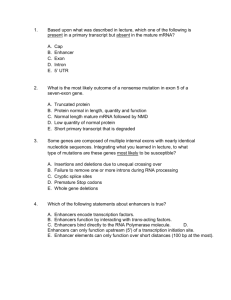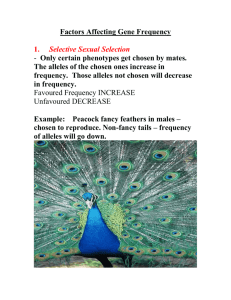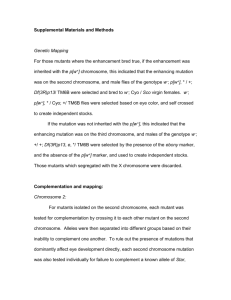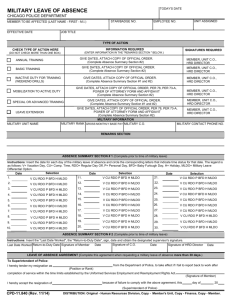Drosophila Problem Set 2011 Problem Set 4: Drosophila Due
advertisement
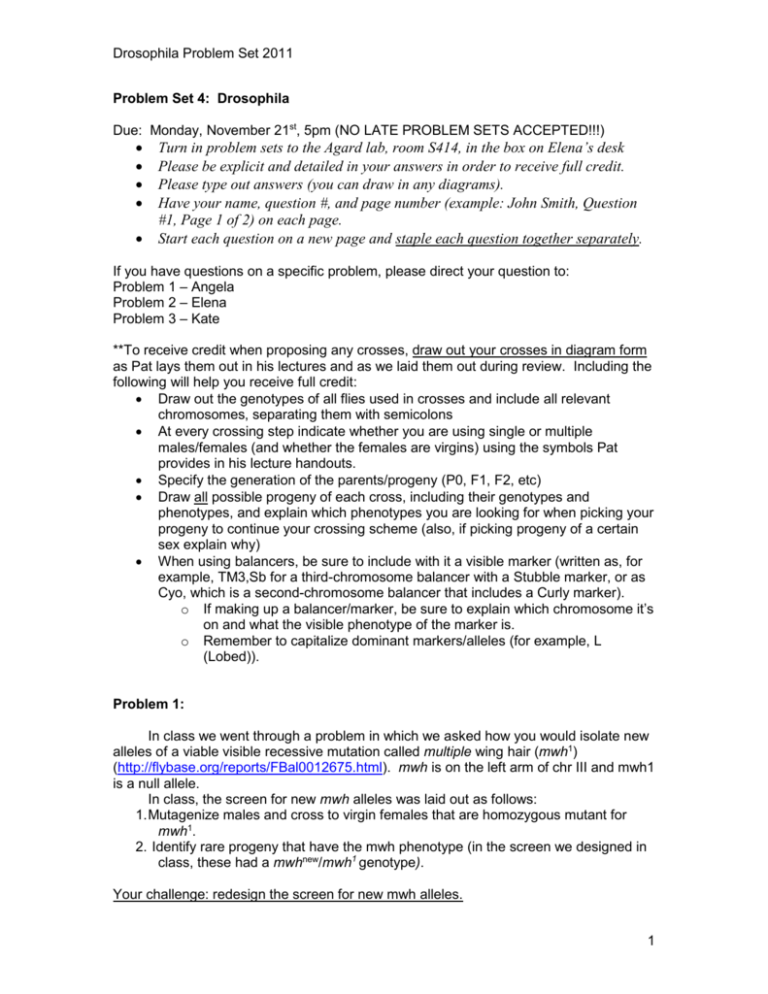
Drosophila Problem Set 2011 Problem Set 4: Drosophila Due: Monday, November 21st, 5pm (NO LATE PROBLEM SETS ACCEPTED!!!) Turn in problem sets to the Agard lab, room S414, in the box on Elena’s desk Please be explicit and detailed in your answers in order to receive full credit. Please type out answers (you can draw in any diagrams). Have your name, question #, and page number (example: John Smith, Question #1, Page 1 of 2) on each page. Start each question on a new page and staple each question together separately. If you have questions on a specific problem, please direct your question to: Problem 1 – Angela Problem 2 – Elena Problem 3 – Kate **To receive credit when proposing any crosses, draw out your crosses in diagram form as Pat lays them out in his lectures and as we laid them out during review. Including the following will help you receive full credit: Draw out the genotypes of all flies used in crosses and include all relevant chromosomes, separating them with semicolons At every crossing step indicate whether you are using single or multiple males/females (and whether the females are virgins) using the symbols Pat provides in his lecture handouts. Specify the generation of the parents/progeny (P0, F1, F2, etc) Draw all possible progeny of each cross, including their genotypes and phenotypes, and explain which phenotypes you are looking for when picking your progeny to continue your crossing scheme (also, if picking progeny of a certain sex explain why) When using balancers, be sure to include with it a visible marker (written as, for example, TM3,Sb for a third-chromosome balancer with a Stubble marker, or as Cyo, which is a second-chromosome balancer that includes a Curly marker). o If making up a balancer/marker, be sure to explain which chromosome it’s on and what the visible phenotype of the marker is. o Remember to capitalize dominant markers/alleles (for example, L (Lobed)). Problem 1: In class we went through a problem in which we asked how you would isolate new alleles of a viable visible recessive mutation called multiple wing hair (mwh1) (http://flybase.org/reports/FBal0012675.html). mwh is on the left arm of chr III and mwh1 is a null allele. In class, the screen for new mwh alleles was laid out as follows: 1. Mutagenize males and cross to virgin females that are homozygous mutant for mwh1. 2. Identify rare progeny that have the mwh phenotype (in the screen we designed in class, these had a mwhnew/mwh1 genotype). Your challenge: redesign the screen for new mwh alleles. 1 Drosophila Problem Set 2011 There are two things you are expected to do in this exercise to receive full credit: 1. You need to distinguish the new allele (mwhnew) from the old allele (mwh1). 2. You need to isolate the new allele in a stock. How would you do this using genetics (not sequencing)? If you need to introduce other markers, feel free to invent any that you need and simply specify which chromosome they are on, whether they are dominant or recessive, and if appropriate whether they have a special linkage relationship. It is usually not useful to isolate new mutations on a Balancer, so please do not use this approach. If you get a different answer than your classmate, don’t worry too much — there are at least two different and excellent answers. Yes I already asked you to figure this out – and if you did, you are ahead of the game. Problem 2 You’ve isolated a dominant mutation that transforms the lens cells that cap each ommatium of the compound eye into pigment cells. You’ve called this mutant Bfd (Blind folded). Very little is known about the signaling pathways that direct appropriate fate decisions of lens and pigment cells, so you decide to use this mutation to ask something about the regulation and you begin as follows: a) You map Bfd to the middle of the Right arm of chromosome II using recombination, roughly two recombination units to the right of engrailed which is at 49A. You examine flies with heterozygous deficiencies that cover the expected area of the locus and none show the dominant Bfd phenotypes. What does this tell you about your mutant? b) Bfd homozygotes are mostly dead, with a few escapers almost making it out of the pupal case, but Bfd survives as a transheterozygote with a Df for the region. In fact, the expressivity of the Bfd phenotype measured as the % of pigmented lenses drops from 90% (in Bfd/+) to 64% (in Bfd/Df). How do you interpret these findings? c) You combine Bfd/+ with another copy of the region carried on a Duplication (an X-ray induced rearrangement, which for illustration could be an insertional translocation in which a region from 47D to 52C is moved to chromosome III. When this modified chromosome III is present with two normal chromosome IIs there are three copies of the cognate region of chromosome II). You find that the Bfd phenotype is still obvious and it is even more severe with 98% of lenses pigmented. What does this tell you? Does it fit with the findings in a and b? d) On the basis of the findings so far, you mutagenize Bfd cn/Lobe males (cn is a recessive chromosome II eye color mutant cinnabar) and cross to Lobe/SM5 virgin females. Among the F1 progeny you find rare Cy flies that are neither Lobe nor Bfd. What might they be? e) What would you do with the exceptional progeny identified in d, and what would you expect to learn? 2 Drosophila Problem Set 2011 Problem 3 You find a mutant on chromosome II that constantly turns right and runs in tight little circles (right turner, rigturn). Curious about this behavior you conduct a screen for other genes on chromosome II that might have a similar phenotype. You find a small number of mutations that cause related phenotypes: three mutants turn left (left turner, lefturn) two do not turn unless they collide with something (straight runner, strun), four more turn right as does your original mutation. Complementation tests show that there is only one complementation group for each category of phenotype: all left turning mutants fail to complement each other, all straight runners fail to complement each other, all right turners fail to complement each other, On the other hand, members of each group complement members of the other groups. Your effort to conduct epistasis tests is hindered by extremely tight linkage of the different genes defined by the complementation tests. You then conduct an allele screen for more alleles of your original right turning mutant and isolate 5 mutations that fail to complement the original right turning mutant (complementation tests yield right turners). In addition, all of the alleles isolated in this allele screen are lethal when made homozygous and these homozygotes exhibit severe neuroanatomical defects at the time of larval death. If these lethal alleles are placed in trans to left turning mutants and straight running mutants, the transheterozygotes are viable and exhibit the left turning or the straight running phenotypes, respectively. Thus the lethal alleles fail to complement all of the mild behavioral mutations even though these belong to three different complementation groups. Note that inter se crosses among the lethal alleles show that these are lethal when these are combined in transheterozygotes: that is, by this criterion they are all in the same complementation group. Since you suspect that the lethal alleles might be large deletions taking out several complementation groups, you set up crosses to test for recombination among the different mutants. You find that you do get rare recombinants between the right turning alleles and the lethal alleles. This suggests that the right turning alleles are about 10 kb away from the lethal alleles. Additionally, you get even fewer recombinants between the lethal alleles and the left turning alleles or the straight running alleles, but you still get a few. Construct a model for a locus that might encode functions giving these phenotypes. If you are confused, you are not the first. Such genetic behaviors have been around for along time (e.g. Lewis E.B. (1951) Pseudoallelism and gene evolution. Cold Spring Harbor Symp. Quant. Biol. 16:159-174). In approaching this please address the following to receive full credit: A. Why does tight linkage complicate an epistasis analysis? B. Does the tight linkage contribute to your model of the locus? How and why? 3 Drosophila Problem Set 2011 C. Your lethal alleles cannot be explained by a deletion in the three linked loci that govern turning behavior. Why not? Your big challenge: explain why the lethal alleles fail to complement mutations that define three different complementation groups. D. Draw a diagram of your model for a locus that might encode functions giving the phenotypes described above. In addition to drawing your model: i. Fully address how your model explains the genetic findings described in this problem. Be sure to explain how your model accounts for the complementation pattern seen for the different mutations. ii. Provide an example of the biological function(s) that might be damaged by the different mutations. 4


